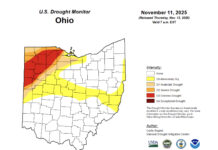The Class III price moved from $24.31 in April to $22.57 in May followed by $21.36 in June. As I write this column (July 20), the July Class III futures are trading at $21.51/cwt. But for the remaining months of 2014, the Class III futures are averaging $20.33, with a low of $19.20 in December.
Traders of futures contracts are thus expecting a gradual softening of domestic milk prices for the remainder of the year. This doesn’t mean that what traders are thinking will be realized…the surprise is really how strong these prices are compared to world prices.
In the latter part of 2013, domestic prices were significantly lower than world prices, thus partially explaining the surge in exports of U.S. dairy products. Many are now thinking that a significant proportion of our current exports is the results of contractual agreements that were put in place months ago when our dairy product prices were still attractive to international buyers. If this is in fact true, then we should expect a progressive drying off of our exports in the incoming months.
This milk that was previously exported will have to find a home in our domestic market. This additional domestic supply from reduced exports compounded with the increased milk supply to be expected from the strong margins currently experienced by dairy producers would point to significantly lower milk prices in the future. That this expected surge in domestic supply, combined with significantly lower feed costs expected from the incoming bumper crop hasn’t been reflected yet in the futures markets all the way to December 2014 is really puzzling.
The national Cow-Jones II (CJ-II) – an index tracking dairy margins across the nation – averaged $10.88/cwt in June, a drop of $1.39/cwt from May and of $2.74/cwt from the peak of March. This margin is still far above what we calculate as the break-even margin ($7.50/cwt) that marks the threshold of positive milk margins for the dairy sector as a national aggregate.
The average national cost of feed dry matter was again exceeding 15 cents per pound in June because feed markets had not yet realized the size of the incoming corn and soybean crops. Futures prices of feeds have softened considerably since early July. As of today (7/20), September corn futures have settled at $3.71/bu. With feed costs expected to drop by 15 to 20 percent in the fall compared to early spring prices, even $19/cwt Class III prices would result in very comfortable margins to dairy producers.













Thank you for this excellent insight in the dairy market.
Perhaps my persistent questioning of the discrepancy between US and NZ dairy product prices is paying off, ha ha.
I never got a real good response from any one about this. Including from the very knowledgeable analyst of Rabo Bank, Tim hunt. I am not sure if your explanation for the reversal of the price differential is a major factor or just a contributing one.
Is it possible that finally our dairy Coops learned something about marketing and are outsmarting Fonterra? However,I still think the Chinese trading in milk products may not be as free and market dependant as it looks. The government’s hands could be manipulating and directing the trader’s sourcing choices in many subtle way.
Suddenly, our higher Somatic cell count is not an issue or the pasture-milk production is not an advantage for NZ?
Sincerely,
AA
Interesting comment. I am not particularly knowledgeable of Chinese government interaction with dairy commodity trading, so can’t comment on that.
The current premium of Dairy America’s medium heat SMP (CP2) versus NZ’s medium heat SMP (CP2) shows up on the GDT. However, this has happened before, then reversed course. Other possible explanations of the NZ price premium include transportion and the CWT program. US prices could be slightly less because there are higher transport costs and this is being built into the price. Fonterra could receive good freight rates due to higher volumes. Also, although the CWT program is touted as a sucessful program, the downside is that it could train foreign buyers to expect US discounts. I am not certain these are the main drivers (such as perceived quality or other factors), but could be part of the equation.